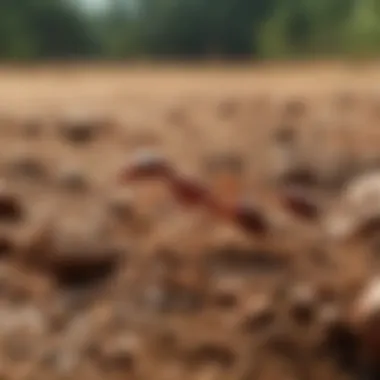Effective Strategies to Prevent Fire Ant Infestation


Intro
Fire ants are more than just a nuisance; they pose significant threats both to agriculture and human comfort. Their aggressive behavior and extensive nesting habits can quickly transform a peaceful outdoor space into a battlefield. Understanding effective control measures is essential for homeowners who wish to prevent the spread of these invasive pests. This guide aims to equip readers with practical insights on identifying, preventing, and treating fire ant infestations effectively.
Identification of Fire Ants
Recognizing fire ants is the first step in managing them effectively. Two prominent types are the red imported fire ant and the black imported fire ant. Here are some characteristics to help in identification:
- Size: Fire ants typically range from 1/8 to 1/2 inch.
- Color: They are usually reddish-brown.
- Nests: Look for mounds in sunny areas, often with no visible entry points.
To avoid confusion, here’s a key descriptor for fire ant colonies:
“The mounds are often larger than those of other ant species, and they can be several feet wide.”
Preventive Measures
Preventing the spread of fire ants involves a series of strategic steps. Here are several measures you might consider:
- Maintain Cleanliness: Keep your yard free from food debris that can attract ants.
- Lawn Care Practices: Regular mowing and maintaining healthy grass can deter nesting.
- Monitoring for Signs: Frequent checks for nests during warm months can help catch infestations early.
Incorporating these practices into your routine can substantially reduce the likelihood of fire ants establishing colonies in your yard.
Treatment Strategies
Should fire ants invade your property, targeted treatment strategies are essential. Here are several recommended approaches:
- Baits: Use fire ant baits that workers carry back to the nest. Products like Amdro and Ortho are commonly chosen for this task.
- Drenching Techniques: This involves applying insecticides directly to the nests. Products containing Permethrin or Lambda-cyhalothrin can be effective here.
- Professional Help: Consider hiring pest control professionals for severe infestations. They can provide tailored solutions to your problem.
Synthesize and Adapt
Success in controlling fire ants requires diligence and adaptability. As new fire ant colonies emerge, continuous monitoring and adjusting methods is crucial. Keep informed through resources such as Wikipedia and Britannica for the latest recommendations and advancements.
By adopting proactive and reactive strategies, homeowners can significantly minimize the risk of fire ant invasions. Knowledge and consistent effort are key to a fire ant-free environment.
Understanding Fire Ants
Understanding fire ants is crucial for homeowners facing the threat of these aggressive pests. Fire ants are not only a nuisance, but they pose significant risks to both agriculture and human health. Knowing their biology, behavior, and the signs of infestations helps in implementing effective control measures. This section lays the groundwork for the remainder of the article, enabling readers to make informed decisions regarding prevention and treatment.
Biology and Behavior
Fire ants, primarily belonging to the genus Solenopsis, have a complex social structure and unique biological traits. They can be identified by their reddish-brown color and aggressive nature. A single colony can contain thousands of ants, including workers, soldiers, and reproductive individuals. Understanding their nesting habits is essential. They construct mounds in sunny, open areas, which can be easily observed in lawns and gardens.
Their diet varies and includes proteins, sugars, and fats, which they gather from a range of sources. This omnivorous nature allows fire ants to thrive in various environments. Behaviorally, fire ants tend to attack when their nest is disturbed. Their painful sting is well-known, causing discomfort and, in some cases, allergic reactions in humans and pets. The knowledge of their biology and behavior is vital in formulating a strategic response to their presence.
Identifying Infestations
Recognizing fire ant infestations early can significantly reduce the damage they cause. Signs include visible mounds in your garden, often appearing shortly after heavy rain. These mounds can be unsightly and hazardous, especially to children and pets. Another indicator is the presence of worker ants, which are constantly foraging for food.
To confirm an infestation:


- Look for small, reddish-brown ants scuttling near food sources.
- Be aware of disturbances in the soil or mounds that seem to appear out of nowhere.
- Monitor the area for bites or stings, which indicate increased ant activity.
"Recognizing the early signs of fire ant infestations can save homeowners from costly damages and health risks."
Accurate identification not only allows for timely intervention but also helps in applying the right control measures. It is advisable to act quickly to prevent the colony from expanding and infesting other areas.
Why Fire Ants Spread
Understanding why fire ants spread is crucial in the battle against these invasive pests. Fire ants are not just a nuisance; they can cause significant harm to gardens, landscapes, and even health. Their ability to rapidly expand their colonies makes it essential for homeowners to grasp the factors that contribute to their proliferation. By comprehending these elements, effective preventive measures and control strategies can be established.
Nesting Habits
Fire ants typically establish their nests in sunny, open spaces. Their nests can be easily recognized by the characteristic mound structure. These mounds can vary in size and are often made from loose soil. Fire ants prefer areas with good drainage and access to food sources, which is why gardens and lawns are frequent targets. They can build multiple nests, and this allows them to expand their territory. A single colony may produce numerous queens, which increases reproduction rates.
Understanding their nesting habits helps in locating and targeting nests with appropriate methods. Removing the nests is critical to reducing their populations. Techniques like pouring boiling water on mounds or using specialized tools can be effective. Homeowners should be aware that fire ants may relocate to avoid threats, so vigilance is key when attempting to manage their spread.
Environmental Factors
Also, various environmental factors can influence the spread of fire ants. Warm climates promote the growth of fire ant colonies. They thrive in regions that maintain a mild winter, allowing them to remain active year-round. Areas with high moisture levels also support the establishment of their nests. Soil type plays a role too; sandy soils, typical in certain parts of the southern United States, can facilitate easier digging of nests.
Moreover, disturbances in the environment can exacerbate their spread. Construction, landscaping, or other changes in land use can transport fire ants and their nests to new areas. Additionally, the movement of contaminated soil or potted plants can inadvertently introduce them to new locations. It is vital for homeowners to consider these aspects when managing their properties to prevent the encroachment of fire ants.
"The key to controlling fire ants lies in understanding their habits and the environmental conditions that promote their spread. Awareness is the first step toward effective action."
From nesting habits to environmental factors, recognizing why fire ants spread can inform how we manage them effectively. By taking these factors into account, homeowners can develop preventive strategies tailored to their unique circumstances, ultimately reducing the chances of fire ant infestation.
Impact of Fire Ant Infestations
Fire ants are more than just a nuisance; they have tangible effects on both the environment and human health. Understanding these impacts is crucial for homeowners looking to mitigate the spread of this invasive species. Effective management requires a comprehensive approach that addresses the intricate dynamics of infested areas. Here, we delve into the specific implications of fire ant infestations, emphasizing the necessity for awareness and action.
Effects on Gardens and Landscapes
The presence of fire ants in gardens and landscapes can lead to significant disruptions. They create mounds that can alter the aesthetics of a lawn, causing uneven surfaces and potential damage to machinery or tools used for maintenance. Moreover, these insects can disrupt soil structure, leading to erosion and reduced fertility over time.
Fire ants also pose the risk of devastation to local flora. Their aggressive hunting behavior results in the consumption of various beneficial insects, which can lead to an imbalance in the ecosystem. Pollinators, such as bees and butterflies, may be notably affected, reducing crop yields and flower productivity. Homeowners should be aware that the long-term presence of fire ants can lead to costly landscape repairs and an increased need for chemical treatments to manage the infestation.
Health Risks to Humans and Pets
In addition to environmental impacts, fire ants present serious health risks to humans and pets. Their bites are painful and can cause allergic reactions in some individuals. Severe infestations in residential areas may lead to increased encounters with these ants, raising the likelihood of painful stings. In extreme cases, stings can result in anaphylaxis, requiring immediate medical attention.
Pets are not exempt from these threats. Dogs and cats can suffer from painful bites if they disturb fire ant mounds or if ants invade their living spaces. This can lead to anxiety in pets and stress for their owners. It’s essential to keep pets under supervision in areas known for fire ant activity. Providing education on the signs of fire ant infestations can be beneficial in protecting both human and animal health.
Awareness and proactive measures can significantly lessen the adverse impacts of fire ants, safeguarding both landscapes and our health.
In summary, the consequences of fire ant infestations extend beyond mere annoyance. They necessitate immediate attention and strategic action from homeowners to preserve the integrity of gardens and landscapes, as well as protect human and pet health.
Preventive Measures
Understanding preventive measures is essential in the fight against fire ant infestations. Appropriate strategies not only help to stop the spread but also minimize the potential damage to gardens, landscapes, and homes. Implementing effective preventive practices saves property owners both time and money in the long run. This section will delve into cultural practices, landscape management, and monitoring techniques, all targeted to keep fire ants at bay.
Cultural Practices


Cultural practices play a significant role in controlling fire ant populations. These methods focus on modifying the environment to make it less hospitable for ants. One important practice is maintaining healthy soil. Well-aerated and nutrient-rich soil promotes strong plant growth, which can minimize the damage caused by fire ants. If plants are robust, they can better withstand pest infestations, including fire ants.
Additionally, practices like proper irrigation and drainage can limit fire ant nesting. Fire ants thrive in moist, water-logged areas. Therefore, ensuring that water drains appropriately can deter them from establishing colonies around your property. Keeping lawns mowed and clear of debris also helps. Tall grass and piles of leaves provide excellent cover for these pests.
Another cultural approach involves the use of beneficial insects. Ladybugs and lacewings can act as natural predators to pests that may attract fire ants. Encouraging these insects in your garden promotes a balanced ecosystem that can keep fire ants away.
Landscape Management
Proper landscape management can significantly reduce the risk of fire ant infestations. It is crucial to select plants that are less attractive to these pests. Native plants typically require less maintenance. They adapt better to local conditions and often don't attract fire ants as much as exotic species do.
Creating physical barriers can also be effective. For instance, using mulch in garden beds can prevent fire ants from nesting. However, it's important to use mulch types that do not retain excess moisture, as this can attract the ants back. Gravel or rock borders around properties can serve as a deterrent, making it more difficult for ants to travel and establish their colonies.
Regularly inspecting your landscape for signs of fire ant activity is also vital. Early detection can lead to quicker action and potentially limit the spread of an infestation. When mounds are spotted, prompt action is needed.
Monitoring Techniques
Monitoring techniques are essential for recognizing and controlling fire ant populations. Regular checks around your yard and garden are the first line of defense. Homeowners should be aware of common signs of fire ant activity, which include visible mounds or disturbed soil. A proactive approach can help catch infestations before they escalate.
Using tools like bait traps can assist in monitoring fire ant populations. These traps can help identify areas of activity and allow for targeted treatments. Homeowners can also consider investing in professional pest monitoring services. These experts utilize advanced technologies and techniques for detection, such as thermal imaging, which can identify subterranean nests.
Recording data over time will help track changes in fire ant activity. This information can inform future pest management strategies and adapt preventive measures accordingly. Implementing effective monitoring will help to ensure that fire ant populations remain under control and that your property remains safe from their aggressive spread.
“Proactive monitoring and management can often prevent infestations before they become widespread.”
Overall, preventive measures form a comprehensive strategy against fire ants. By integrating cultural practices, implementing thoughtful landscape management, and employing rigorous monitoring techniques, property owners can effectively reduce the likelihood of fire ant spread. Vigilance and preparation are key to maintaining a fire ant-free environment.
Effective Control Methods
Controlling fire ants effectively is critical for homeowners looking to maintain a comfortable and safe environment. This section provides a detailed exploration of the various control methods available. It emphasizes the necessity of understanding the strengths and limitations of each method. Effective control not only mitigates current infestations but helps in preventing future ones, making it an important strategy for long-term management.
Chemical Treatments
Chemical treatments are often the first line of defense against fire ant infestations. These treatments are designed to kill ants quickly and can be categorized mainly into insecticides and baits.
- Insecticides: These are primarily aimed at immediate eradication. They can be applied as sprays or granules directly to the mounds. It is important to read and follow the application instructions carefully to ensure effectiveness. Some common insecticides include products containing fipronil and acephate. Always consider the safety of pets and children when applying these chemicals.
- Baits: Bait products are slower-acting but target the colony more effectively. The ants carry the bait back to their nest, where it can kill the queen and other ants. This method can be more effective in the long run but requires patience as it might take several days to notice significant results. Products containing hydramethylnon or spinosad are commonly used in these cases. It’s crucial to apply baits in the afternoon or evening when ants are most active to increase the chances of uptake.
The effectiveness of chemical treatments greatly hinges on correctly identifying the right product and method for your specific situation.
Biological Controls
Biological control methods involve using natural predators or parasites to manage fire ant populations. While not as widely utilized as chemical methods, they can play a significant role in integrated pest management.
- Natural Enemies: Certain organisms, such as nematodes, can be introduced to the soil to infect and kill fire ants. This method targets the ants while minimizing impact on other wildlife. Another example is the use of parasitic phorid flies that specifically target fire ants, disrupting their colony structures.
- Environmental Management: This involves creating conditions that make the environment less hospitable to fire ants. Practices like encouraging native plants can attract natural predators, which indirectly helps control the fire ant population. Implementing these methods often requires ongoing commitment but can yield positive outcomes over time.
Integrated Pest Management
Integrated pest management (IPM) is a holistic approach that combines multiple strategies to effectively control fire ants. It is about finding the right balance among chemical, biological, and cultural methods. IPM focuses on long-term solutions rather than quick fixes, optimizing both effectiveness and environmental responsibility.
- Monitoring and Assessment: Keeping a close eye on fire ant populations is necessary. Regular assessments can lead to early detection of infestations, allowing for prompt response.
- Cultural Practices: Proper lawn care and landscaping practices can discourage fire ant nesting. This includes maintaining soil health, managing moisture levels, and avoiding conditions that favor their spread.
- Community Involvement: Engaging neighbors and local groups can amplify efforts against fire ant infestations. Community-wide strategies can be more effective than individual actions, especially when it comes to large-scale infestations.


Implementing an IPM strategy allows homeowners to adapt to changing conditions while managing fire ants sustainably.
Choosing the Right Strategy
Choosing the right strategy is vital in the fight against fire ants. A well-planned approach can make the difference between a minor inconvenience and a full-blown infestation. It is essential to consider multiple factors, including the extent of the infestation, available resources, and the specific characteristics of the affected area. Homeowners must grasp the variety of control methods available. Each method has its benefits and limitations, therefore understanding them paves the way for a more effective treatment plan.
Assessing the Infestation
Before implementing any control measures, it is crucial to assess the severity of the fire ant infestation. This process involves closely examining your property for signs of fire ant colonies. An infestation can vary in scale, from a single mound to multiple sites scattered across a yard. To evaluate this:
- Look for visible ant mounds, which are typically soft and loose soil formations.
- Monitor ant activity, especially during the warmer months when they are most active.
- Check for ant trails leading to food sources or nesting sites.
Once you have a clear understanding of the extent of the problem, you can proceed with selecting an appropriate strategy for control. Ignoring proper assessment may lead to ineffective methods that fail to address the core issues.
Cost Considerations
When determining a strategy to control fire ants, financial implications are a significant concern. The costs can range widely based on the methods chosen, the size of the infestation, and the need for professional assistance.
- DIY Methods: If you opt for do-it-yourself treatments, the costs for products can be reasonable. For example, bait stations or granular insecticides may only require a moderate investment. However, it is necessary to factor in the time spent implementing these methods and their potential effectiveness.
- Professional Services: Many homeowners choose to enlist the help of pest control companies. While this option often involves higher initial costs, it might provide long-term savings through comprehensive solutions that effectively eliminate ants.
- Long-Term Solutions: Some strategies, while more expensive initially, can lead to savings later on. Preventative measures such as landscape management or community programs may incur upfront costs but will minimize risks in the future.
Long-Term Solutions
Long-term solutions to fire ant infestations are essential for maintaining a pest-free environment. These strategies focus on sustainable practices rather than quick fixes. Implementing effective long-term measures can reduce the likelihood of re-infestation and protect your property year after year. Homeowners are encouraged to think beyond immediate relief and consider how their actions today can influence future fire ant populations.
One important aspect to consider is community involvement. When neighborhoods coordinate efforts to control fire ant populations, it enhances the effectiveness of individual actions. Strong community approaches can lead to a more significant reduction in fire ant presence, as these pests often migrate from one property to another. Collaboration creates unified strategies that can address the issue on a larger scale, making entire areas less hospitable for fire ants.
Another critical factor is the need for education and awareness programs. Initiatives that inform the public about the risks associated with fire ants and effective control methods can transform how infestations are managed. By keeping communities well-informed, homeowners can make better decisions that bolster long-term prevention efforts. Programs that teach residents to identify fire ants and understand their behavior can lead to earlier detection and more prompt action.
"Education is the first defense against invasive species like fire ants. Knowledge empowers homeowners to take control of the situation."
Overall, investing in long-term solutions is a key element in combating the spread of fire ants. By focusing on community involvement and educational programs, homeowners can contribute to building a resilient environment. Employing these strategies provides sustainable benefits, improving not only the aesthetics of gardens but also minimizing health risks that come with fire ant infestations.
Community Approaches
A successful community approach involves organizing local efforts to control fire ant populations. Homeowners can start by forming groups to discuss monitoring techniques and share effective methods for controlling infestations. Regular neighborhood meetings can foster collaboration, encouraging everyone to stay informed and actively participate.
Additionally, local governments or community associations can play a role. They may fund educational workshops, distribute resources, and even coordinate with pest control experts to tackle widespread infestations effectively. By harnessing collective community power, the impact of fire ant control is amplified.
Education and Awareness Programs
Education and awareness programs are pivotal in the fight against fire ants. These programs can take various forms, such as:
- Workshops that focus on identification of fire ants and nesting sites.
- Distribution of informational leaflets detailing prevention and management strategies.
- Use of social media platforms to share successes and tips.
Homeowners should leverage community resources, such as local extension services or universities. These organizations often provide expertise and materials to educate the public.
By prioritizing education, communities can enhance their understanding of fire ants, leading to proactive measures and ultimately a significant decrease in infestations over time.
The End
The conclusion of this article serves a critical role in emphasizing the strategies and practices necessary to combat fire ants. As homeowners, understanding how to stop the spread of these pests not only safeguards your residence but also protects your outdoor spaces and your health. The points discussed throughout this article highlight effective control methods, preventive measures, and the importance of community approaches in managing fire ant populations.
When evaluating your options, several key considerations arise. First, it is crucial to emphasize the significance of early identification. Recognizing the signs of an infestation can lead to quicker intervention, reducing the chances of fire ants establishing larger colonies. Second, employing a combination of strategies can enhance your success; methods like chemical treatments should be combined with biological controls for more robust results.
The notion of proactive management stands out. Engaging in landscape practices to deter new colonies can save time and money in the long run. Moreover, educating yourself and your community can foster collective action, minimizing the risks posed by fire ants.
Overall, consistent efforts towards prevention and control not only improve the immediate environment but also contribute to broader ecological health. Thus, addressing the threat of fire ants is not merely a personal undertaking but a communal responsibility that requires diligence and informed practices.







